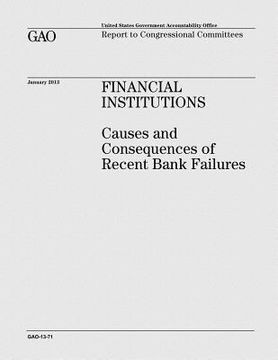Financial Institutions: Causes and Consequences of Recent Bank Failures (in English)
Synopsis "Financial Institutions: Causes and Consequences of Recent Bank Failures (in English)"
Ten states concentrated in the western, midwestern, and southeastern United States-all areas where the housing market had experienced strong growth in the prior decade-experienced 10 or more commercial bank or thrift (bank) failures between 2008 and 2011. The failures of the smaller banks (those with less than $1 billion in assets) in these states were largely driven by credit losses on commercial real estate (CRE) loans. The failed banks also had often pursued aggressive growth strategies using nontraditional, riskier funding sources and exhibited weak underwriting and credit administration practices. The rapid growth of CRE portfolios led to high concentrations that increased the banks' exposure to the sustained real estate and economic downturn that began in 2007. The Department of the Treasury and the Financial Stability Forum's Working Group on Loss Provisioning have observed that the current accounting model for estimating credit losses is based on historical loss rates, which were low in the prefinancial crisis years. The Financial Accounting Standards Board has issued a proposal for public comment for a loan loss provisioning model that is more forward-looking and focuses on expected losses, which would result in banks establishing earlier recognition of loan losses for the loans they underwrite and could incentivize prudent risk management practices. Moreover, it should help address the cycle of losses and failures that emerged in the recent crisis as banks were forced to increase loan loss allowances and raise capital when they were least able to do so. The Federal Deposit Insurance Corporation (FDIC) used shared loss agreements to help resolve failed banks at the least cost during the recent financial crisis. Under a shared loss agreement, FDIC absorbs a portion of the loss on specified assets of a failed bank that are purchased by an acquiring bank. The acquisitions of failed banks by healthy banks appears to have mitigated the potentially negative effects of bank failures on communities, although the focus of local lending and philanthropy may have shifted. First, while bank failures and failed bank acquisitions can have an impact on market concentration-an indicator of the extent to which banks in the market can exercise market power, such as raising prices or reducing availability of some products and services-GAO found only a limited number of metropolitan areas and rural counties were likely to have become significantly more concentrated. The lack of increases in concentration was because in many instances, the failed banks were acquired by out-of-market institutions. Second, GAO's econometric analysis of call report data from 2006 through 2011 found that failing small banks extended progressively less net credit as they approached failure, and that acquiring banks generally increased net credit after the acquisition. However, acquiring bank and existing peer bank officials GAO interviewed noted that in the wake of the bank failures, underwriting standards had tightened and thus credit was generally more available for small business owners who had good credit histories and strong financials than those that did not. Third, officials from regulators, banking associations, and banks GAO spoke with said that involvement in local philanthropy declined as small banks approached failure but generally increased after acquisition. Yet, these acquiring banks may not focus on the same philanthropic activities as did the failed banks. Finally, GAO econometrically analyzed the relationships among bank failures, income, unemployment, and real estate prices for all states and the District of Columbia (states) for the 1994 through 2011 period and found that bank failures in a state were more likely to affect its real estate sector than its labor market or broader economy.

